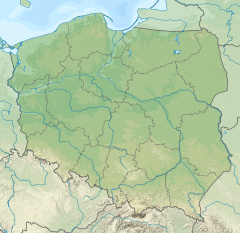Old Town in Warsaw
 |
|
| UNESCO World Heritage Site | |
|---|---|
| Location |
Warsaw, Poland |
| Coordinates | 52°14′59″N 21°00′44″E / 52.2498°N 21.0122°E |
| Criteria | Cultural: (ii), (vi) |
| Reference | 30 |
| Inscription | 1980 (4th Session) |
|
[]
|
|
The Warsaw Old Town (Polish: Stare Miasto, and collectively with the New Town, known colloquially as: Starówka) is the oldest part of the capital city. It is bounded by the Wybrzeże Gdańskie, along with the bank of Vistula river, Grodzka, Mostowa and Podwale Streets. It is one of the most prominent tourist attractions in Warsaw. The heart of the area is the Old Town Market Place, rich in restaurants, cafés and shops. Surrounding streets feature medieval architecture such as the city walls, the Barbican and St. John's Cathedral.
The Old Town was established in the 13th century. Initially surrounded by an earthwork rampart, prior to 1339 it was fortified with brick city walls. The town originally grew up around the castle of the Dukes of Mazovia that later became the Royal Castle. The Market Square (Rynek Starego Miasta) was laid out sometime in the late 13th or early 14th century, along the main road linking the castle with the New Town to the north.
Until 1817 the Old Town's most notable feature was the Town Hall built before 1429. In 1701 the square was rebuilt by Tylman Gamerski, and in 1817 the Town Hall was demolished. Since the 19th century, the four sides of the Market Square have borne the names of four notable Poles who once lived on the respective sides: Ignacy Zakrzewski (south), Hugo Kołłątaj (west), Jan Dekert (north) and Franciszek Barss (east).
In the early 1910s Warsaw Old Town was the home of the prominent Yiddish writer Alter Kacyzne, who later depicted life there in his 1929 novel "שטאַרקע און שוואַכע" (Sterke un Sweche, "The Strong and the Weak"). As depicted in the novel, the Old Town at that time was a slum neighborhood, with poor families - some Jewish, other Christian - living very crowded in subdivided tenements which had once been aristocrats' palaces. Parts of it were bohemian, with painters and artists having their studios, while some streets were a Red-light district housing brothels.
...
Wikipedia

